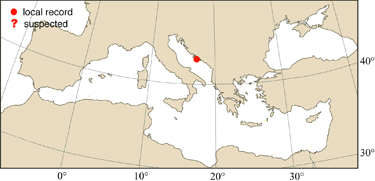
|
Relevant synonyms
Misidentification
Meristic formula
|
|
| photo: A. Zuljevic |
|
SHORT
DESCRIPTION
color : body's background is purplish to dark blue with yellow-edged scales. Nape, lower part of head and anterior part of belly deep blue. Yellow area on the side of head from eye to cheek. Dorsal and anal fins bluish-orange with distinct blue margin. Caudal, pectoral and pelvic fins yellow, the first often with posterior bluish-green edge. Juveniles (up to 10 cm) have five forward-curved horizontal bars.
size : common 20-30 cm (max.45 cm). |
DISTINGUISHING CHARACTERISTICS
BIOLOGY / ECOLOGY
habitat : coral reefs to depths of 70 m. |
|
1st
MEDITERRANEAN RECORD
|

|
|
DISTRIBUTION
|
ESTABLISHMENT SUCCESS
speculated reasons for success :
|
|
|
MODE OF
INTRODUCTION |
IMPORTANCE TO
HUMANS |
|
KEY
REFERENCES
|